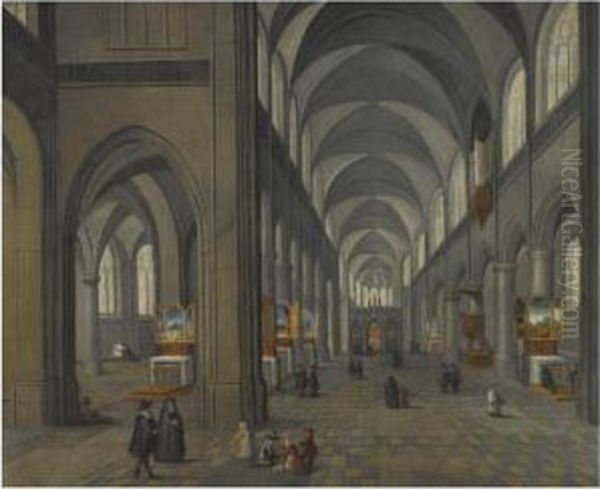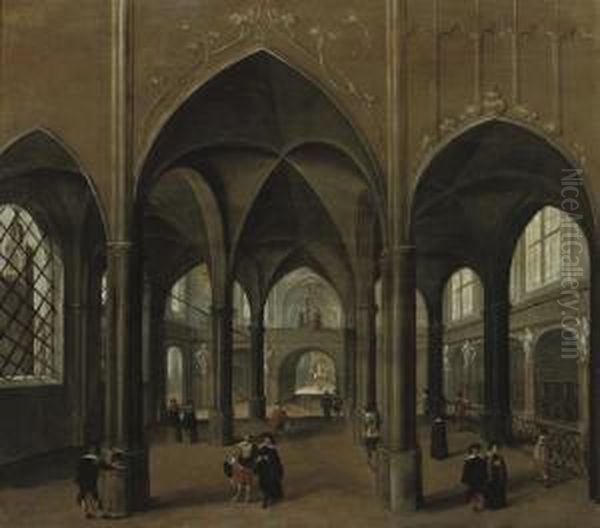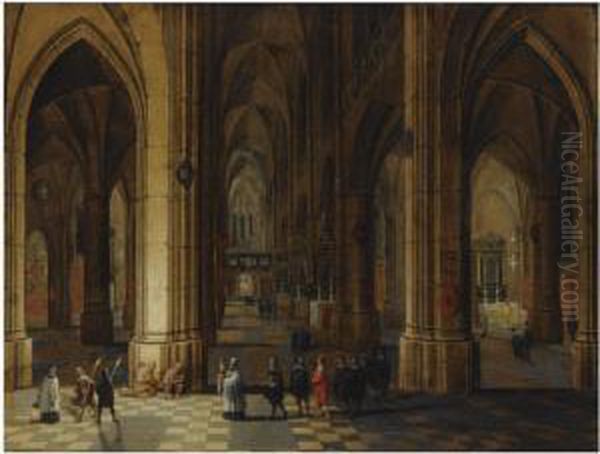Pieter Neefs the Younger (1620 – c. 1675) stands as a notable figure in the rich tapestry of 17th-century Flemish Baroque painting. Specializing in a genre that demanded both meticulous precision and an eye for atmospheric effect – the depiction of church interiors – Neefs the Younger carved out a distinct, albeit sometimes conflated with his father's, identity. His works offer a captivating window into the sacred spaces of his time, rendered with a technical skill that continues to draw admiration. Active primarily in Antwerp, a bustling artistic hub, he contributed significantly to a tradition of architectural painting that flourished in the Low Countries.
Early Life and Artistic Lineage
Born in Antwerp around May 23, 1620, Pieter Neefs the Younger was immersed in art from his earliest days. He was the son of the esteemed painter Pieter Neefs the Elder (c. 1578 – after 1656), who was himself a renowned master of architectural scenes, particularly church interiors. This familial connection was paramount in shaping the younger Neefs's artistic path. He received his initial training directly from his father, learning the intricate techniques of perspective, light, and shadow that were essential for this specialized genre.
The Neefs family was an artistic dynasty, albeit a focused one. Besides his father, Pieter the Younger's brother, Lodewijk Neefs (1617-1649), also became a painter, working in a similar vein. This environment undoubtedly fostered a deep understanding and appreciation for the nuances of depicting complex architectural spaces. The workshop of Pieter Neefs the Elder would have been a place of diligent study, where the principles of linear perspective, as codified by Renaissance theorists and further developed by Northern artists like Hans Vredeman de Vries, were put into practice daily.
Pieter Neefs the Younger absorbed these lessons thoroughly, eventually becoming an independent master. While he never formally registered as a master in the Antwerp Guild of Saint Luke, the city's venerable institution for artists and craftsmen, this was not entirely uncommon for artists who worked primarily within a family workshop or had established patronage. His career unfolded in Antwerp, where he remained active until his death, believed to be around 1675.
The Antwerp Artistic Milieu

To fully appreciate Pieter Neefs the Younger's contribution, it's essential to consider the vibrant artistic environment of 17th-century Antwerp. Despite political and economic shifts, Antwerp remained a leading center for art production in Europe. The city was home to towering figures like Peter Paul Rubens, Anthony van Dyck, and Jacob Jordaens, whose large-scale history paintings and portraits defined the High Baroque style.
However, alongside these giants, a diverse ecosystem of specialized painters thrived. The art market was sophisticated, with patrons and collectors seeking works in various genres, including landscapes, still lifes, genre scenes, and, importantly, architectural paintings. This specialization allowed artists to hone their skills in particular areas, achieving remarkable levels of proficiency. The demand for church interiors, in particular, can be linked to several factors, including civic pride in local monuments, the Counter-Reformation's emphasis on the beauty and sanctity of church spaces, and a general appreciation for perspectival skill.
Artists like Hendrik van Steenwijk the Elder and his son, Hendrik van Steenwijk the Younger, were earlier pioneers in popularizing imaginary and existing church interiors, and their influence, particularly that of the Elder, was significant on Pieter Neefs the Elder, and consequently, on his son. The meticulous detail and serene atmosphere they cultivated became hallmarks of the genre.
Mastery of Architectural Interiors
Pieter Neefs the Younger, following in his father's footsteps, dedicated his oeuvre almost exclusively to the depiction of church interiors. His preferred subjects were the grand Gothic cathedrals of his native Antwerp, most notably the Cathedral of Our Lady. These structures, with their soaring vaults, slender columns, intricate tracery, and vast naves, provided a perfect canvas for showcasing his command of perspective and his sensitivity to light.
His paintings are often characterized by a deep, receding perspective that draws the viewer's eye into the sacred space. He employed a sophisticated understanding of linear perspective, using orthogonal lines converging towards one or more vanishing points to create a convincing illusion of depth and volume. The architectural elements – arches, pillars, ribbed vaults, stained-glass windows, and altarpieces – are rendered with painstaking detail, reflecting a keen observational skill and a patient hand.

The play of light is another crucial aspect of Neefs the Younger's work. He was adept at capturing the way light filters through stained-glass windows, casting subtle hues on stone surfaces, or how candlelight creates pockets of warmth and intimacy in darker recesses. His night scenes, often depicting services illuminated by candles and torches, are particularly atmospheric, showcasing a different facet of his skill in managing complex light sources and their interplay with the surrounding architecture.
Signature Style and Techniques
While the works of Pieter Neefs the Younger and his father share many similarities, making attribution challenging at times, subtle distinctions can often be observed. Art historians note that the Younger's palette could be somewhat cooler or, conversely, sometimes brighter and more varied than his father's. His handling of paint might also exhibit a slightly softer touch in certain areas, though he maintained a high degree of precision overall.
His compositions often feature a central vanishing point, creating a symmetrical and harmonious view down the nave or a transept. However, he also explored more dynamic, oblique angles, offering varied perspectives of the church interiors. The scale of his figures, often added by collaborating artists, is generally well-proportioned to the architectural setting, enhancing the sense of grandeur and realism.
One of the recurring motifs in his work is the depiction of religious services or everyday activities within the church, such as Mass, processions, private prayer, or even casual conversations among visitors. These human elements animate the otherwise static architectural spaces, adding a narrative layer and a sense of lived experience to the scenes. The careful placement of these figures guides the viewer's attention and contributes to the overall compositional balance.
The Art of Collaboration: Staffage in Neefs's Paintings
A common practice in 17th-century Antwerp, particularly among specialized painters, was collaboration. Architectural painters like Neefs the Younger often focused on their area of expertise – the building itself – and enlisted other artists, who specialized in figure painting (known as "staffage"), to populate their scenes. This division of labor allowed each artist to contribute their best skills, resulting in a more polished and marketable final product.
Pieter Neefs the Younger frequently collaborated with several notable figure painters. Perhaps his most consistent and well-documented collaborator was Frans Francken III (1607–1667), a member of the extensive Francken dynasty of painters. Frans III was skilled in rendering small, lively figures that integrated seamlessly into Neefs's architectural settings. These figures, often depicted in contemporary attire, added a sense of immediacy and human interest to the paintings.

Other artists who are believed to have provided staffage for Neefs the Younger include figures from the circle of Jan Brueghel the Younger (though direct collaboration with Jan Brueghel the Elder, who died in 1625, would have been with Neefs the Elder or very early in the Younger's career). David Teniers the Younger (1610-1690), a highly versatile and successful artist known for his peasant scenes and genre paintings, is also sometimes cited as a collaborator, bringing his characteristic lively figures to Neefs's interiors. The elegant figures of Hieronymus Janssens, known as "Den Danser" for his depictions of balls and social gatherings, may also have appeared in some works. Gonzales Coques, primarily a portraitist, also occasionally contributed figures to collaborative works.
These collaborations were symbiotic. Neefs provided the impressive architectural framework, and the figure painters brought life and narrative to the scene. The styles of the collaborators needed to be compatible to ensure a harmonious result, and the success of these partnerships speaks to the professionalism and adaptability of the artists involved.
Notable Works: A Glimpse into Sacred Spaces
Among Pieter Neefs the Younger's oeuvre, several works stand out as representative of his style and skill. One such example is the "Interior of a Gothic Church with People Participating in Mass." This painting, or variations of it, showcases his typical approach: a view down the nave, often from a slightly elevated viewpoint, emphasizing the rhythmic progression of columns and arches. Light streams in from the side, illuminating parts of the architecture while leaving others in shadow, creating a sense of depth and volume. The figures, meticulously painted by a collaborator, are engaged in the rituals of worship, adding to the solemn atmosphere.
Another common theme is the "Interior of Antwerp Cathedral," a subject he revisited multiple times, exploring different viewpoints and lighting conditions. These paintings serve not only as artistic achievements but also as valuable historical documents, offering insights into the appearance and use of this iconic building in the 17th century. The depiction of specific altarpieces, tombs, and architectural details can often be identified, attesting to Neefs's careful observation.
His night scenes, such as "Interior of a Church at Night with a Service," are particularly evocative. In these works, the flickering light of candles and torches creates dramatic contrasts of light and shadow, imbuing the scene with a sense of mystery and spiritual intensity. The architectural details, though partially obscured by darkness, remain discernible, testament to his underlying structural understanding. These nocturnal scenes demonstrate a different kind of virtuosity compared to his daylight interiors, requiring a keen sense of tonal values and light effects.
Distinguishing from Neefs the Elder
The close stylistic similarity between Pieter Neefs the Younger and his father, Pieter Neefs the Elder, has long presented challenges for art historians and connoisseurs. Both artists often signed their works "Pieter Neefs" or "P. NEFS," sometimes adding "de Oude" (the Elder) or "de Jonge" (the Younger), but not consistently. Many works are unsigned or have ambiguous signatures.
Generally, works by the Elder are sometimes considered to have a slightly warmer tonality and perhaps a more meticulous, almost miniature-like precision in the rendering of architectural detail. The Younger's works, while still highly detailed, can sometimes exhibit a slightly broader handling or a different color sensibility, occasionally incorporating cooler blues and grays or more vibrant accents. However, these are subtle distinctions, and the fact that they often worked on similar subjects and compositions, and likely shared workshop patterns, further complicates attribution.
The staffage can sometimes provide clues. If the figure painter can be identified and their period of activity is known, it can help date the painting and potentially distinguish between father and son, especially for works created after the Elder's presumed period of highest activity or after his death. However, since both father and son collaborated with members of the Francken family, this is not always a definitive guide. Ultimately, distinguishing their hands often relies on nuanced stylistic analysis and comparison with securely attributed works.
Influence and Contemporaries in Architectural Painting
Pieter Neefs the Younger operated within a well-established tradition of architectural painting in the Low Countries. Beyond his father and the Steenwijks, other artists were exploring similar themes. In the Dutch Republic, painters like Dirck van Delen, Emanuel de Witte, and Gerard Houckgeest were creating their own distinctive interpretations of church interiors. While Dutch church interiors often reflected the more austere aesthetic of Calvinist worship (though de Witte also painted Catholic churches), the underlying interest in perspective, light, and architectural space was shared. Bartholomeus van Bassen was another Dutch contemporary specializing in imaginary palaces and church interiors.
The work of the Neefs family, both Elder and Younger, contributed to the popularity and refinement of this genre in the Southern Netherlands. Their paintings were sought after by collectors who appreciated the technical skill involved and the serene, ordered beauty of the depicted spaces. While perhaps not as innovative as some of their Dutch counterparts who experimented more radically with perspective and light, the Neefs maintained a consistently high standard of quality and craftsmanship.
The influence of earlier masters like Hans Vredeman de Vries, whose treatises on perspective were widely influential, underpins the entire genre. Vredeman de Vries's complex, often fantastical architectural compositions provided a theoretical and visual foundation upon which later generations, including the Neefs, built.
Later Career and Enduring Legacy
Pieter Neefs the Younger continued to paint throughout the mid-17th century, producing a significant body of work. His paintings found their way into numerous collections across Europe, a testament to their appeal. The consistency of his style and subject matter suggests a steady demand for his particular brand of architectural painting.
His legacy lies in his contribution to the Flemish Baroque tradition and his mastery of a specialized genre. Along with his father, he represents the pinnacle of Antwerp church interior painting. His works are valued not only for their aesthetic qualities – their harmonious compositions, meticulous detail, and evocative use of light – but also as historical records of ecclesiastical architecture and religious life in 17th-century Antwerp.
Today, paintings by Pieter Neefs the Younger are held in major museums and private collections worldwide, including the Louvre in Paris, the Prado in Madrid, the National Gallery in London, and the Rijksmuseum in Amsterdam. They continue to be studied for their technical brilliance and their ability to transport the viewer into the sacred and majestic spaces of a bygone era. His dedication to this specific niche within the art world ensured that his name, and that of his father, would be inextricably linked with the captivating genre of architectural interiors.
Conclusion: An Artist of Precision and Atmosphere
Pieter Neefs the Younger was an artist who excelled within the parameters of his chosen specialization. Inheriting a strong artistic tradition from his father, he developed his skills to become a leading exponent of church interior painting in 17th-century Antwerp. His meticulous rendering of Gothic architecture, his sensitive handling of light and shadow, and his successful collaborations with skilled figure painters resulted in works that are both technically impressive and atmospherically engaging.
While the shadow of his father and the complexities of attribution sometimes cloud his individual identity, Pieter Neefs the Younger's substantial body of work speaks for itself. He was a master of perspective, a careful observer of architectural detail, and an artist capable of imbuing his scenes with a sense of serenity and devotion. His paintings remain a testament to the rich artistic culture of Baroque Antwerp and the enduring appeal of finely crafted architectural representation, securing his place as a significant contributor to Flemish art history. His works invite contemplation, not just of the sacred spaces they depict, but also of the remarkable skill and dedication of the artist who brought them to life on canvas.